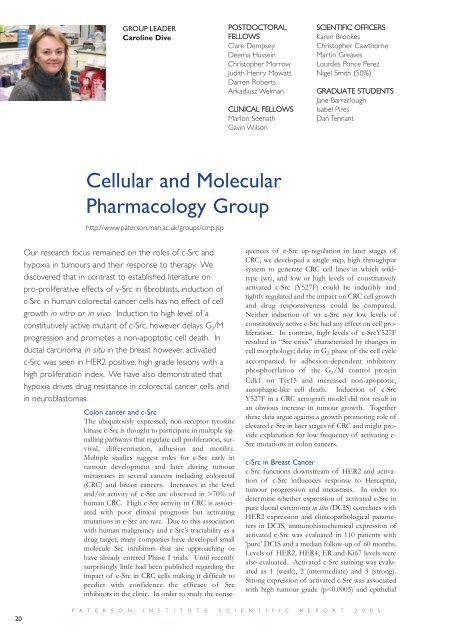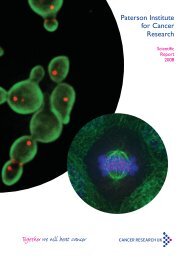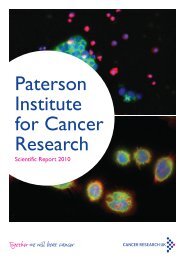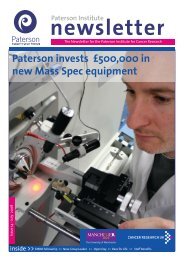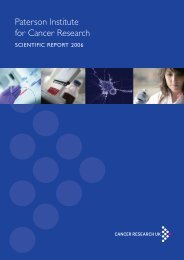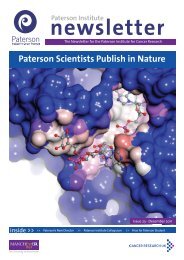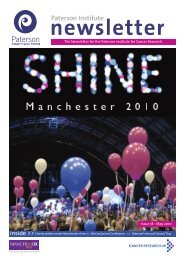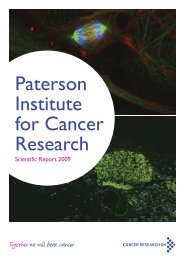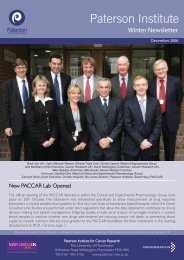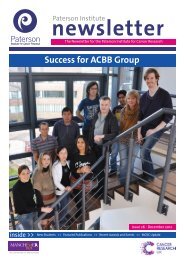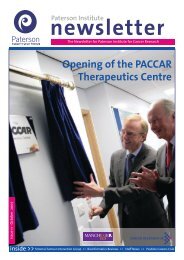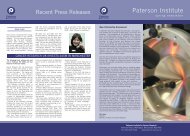Paterson Institute for Cancer Research SCIENTIFIC REPORT 2005
Paterson Institute for Cancer Research SCIENTIFIC REPORT 2005
Paterson Institute for Cancer Research SCIENTIFIC REPORT 2005
Create successful ePaper yourself
Turn your PDF publications into a flip-book with our unique Google optimized e-Paper software.
20<br />
GROUP LEADER<br />
Caroline Dive<br />
Cellular and Molecular<br />
Pharmacology Group<br />
http://www.paterson.man.ac.uk/groups/cmp.jsp<br />
Our research focus remained on the roles of c-Src and<br />
hypoxia in tumours and their response to therapy. We<br />
discovered that in contrast to established literature on<br />
pro-proliferative effects of v-Src in fibroblasts, induction of<br />
c-Src in human colorectal cancer cells has no effect of cell<br />
growth in vitro or in vivo. Induction to high level of a<br />
constitutively active mutant of c-Src, however delays G 2/M<br />
progression and promotes a non-apoptotic cell death. In<br />
ductal carcinoma in situ in the breast however, activated<br />
c-Src was seen in HER2 positive, high grade lesions with a<br />
high proliferation index. We have also demonstrated that<br />
hypoxia drives drug resistance in colorectal cancer cells and<br />
in neuroblastomas.<br />
Colon cancer and c-Src<br />
The ubiquitously expressed, non-receptor tyrosine<br />
kinase c-Src is thought to participate in multiple signalling<br />
pathways that regulate cell proliferation, survival,<br />
differentiation, adhesion and motility.<br />
Multiple studies suggest roles <strong>for</strong> c-Src early in<br />
tumour development and later during tumour<br />
metastases in several cancers including colorectal<br />
(CRC) and breast cancers. Increases in the level<br />
and/or activity of c-Src are observed in >70% of<br />
human CRC. High c-Src activity in CRC is associated<br />
with poor clinical prognosis but activating<br />
mutations in c-Src are rare. Due to this association<br />
with human malignancy and c-Src’s tractability as a<br />
drug target, many companies have developed small<br />
molecule Src inhibitors that are approaching or<br />
have already entered Phase I trials. Until recently<br />
surprisingly little had been published regarding the<br />
impact of c-Src in CRC cells making it difficult to<br />
predict with confidence the efficacy of Src<br />
inhibitors in the clinic. In order to study the conse-<br />
POSTDOCTORAL<br />
FELLOWS<br />
Clare Dempsey<br />
Deema Hussein<br />
Christopher Morrow<br />
Judith Henry Mowatt<br />
Darren Roberts<br />
Arkadiusz Welman<br />
CLINICAL FELLOWS<br />
Marlon Seenath<br />
Gavin Wilson<br />
<strong>SCIENTIFIC</strong> OFFICERS<br />
Karen Brookes<br />
Christopher Cawthorne<br />
Martin Greaves<br />
Lourdes Ponce Perez<br />
Nigel Smith (50%)<br />
GRADUATE STUDENTS<br />
Jane Barraclough<br />
Isabel Pires<br />
Dan Tennant<br />
quences of c-Src up-regulation in later stages of<br />
CRC, we developed a single step, high throughput<br />
system to generate CRC cell lines in which wildtype<br />
(wt), and low or high levels of constitutively<br />
activated c-Src (Y527F) could be inducibly and<br />
tightly regulated and the impact on CRC cell growth<br />
and drug responsiveness could be compared.<br />
Neither induction of wt c-Src nor low levels of<br />
constitutively active c-Src had any effect on cell proliferation.<br />
In contrast, high levels of c-SrcY527F<br />
resulted in “Src crisis” characterized by changes in<br />
cell morphology; delay in G 2 phase of the cell cycle<br />
accompanied by adhesion-dependent inhibitory<br />
phosphorylation of the G 2/M control protein<br />
Cdk1 on Tyr15 and increased non-apoptotic,<br />
autophagic-like cell death. Induction of c-Src<br />
Y527F in a CRC xenograft model did not result in<br />
an obvious increase in tumour growth. Together<br />
these data argue against a growth promoting role of<br />
elevated c-Src in later stages of CRC and might provide<br />
explanation <strong>for</strong> low frequency of activating c-<br />
Src mutations in colon cancers.<br />
c-Src in Breast <strong>Cancer</strong><br />
c-Src functions downstream of HER2 and activation<br />
of c-Src influences response to Herceptin,<br />
tumour progression and metastasis. In order to<br />
determine whether expression of activated c-Src in<br />
pure ductal carcinoma in situ (DCIS) correlates with<br />
HER2 expression and clinicopathological parameters<br />
in DCIS, immunohistochemical expression of<br />
activated c-Src was evaluated in 110 patients with<br />
‘pure’ DCIS and a median follow-up of 60 months.<br />
Levels of HER2, HER4, ER and Ki67 levels were<br />
also evaluated. Activated c-Src staining was evaluated<br />
as 1 (weak), 2 (intermediate) and 3 (strong).<br />
Strong expression of activated c-Src was associated<br />
with high tumour grade (p


